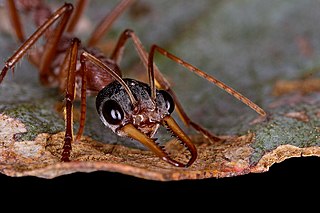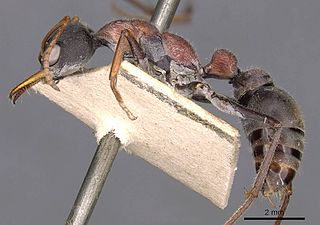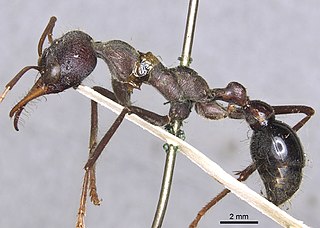
Myrmecia is a genus of ants first established by Danish zoologist Johan Christian Fabricius in 1804. The genus is a member of the subfamily Myrmeciinae of the family Formicidae. Myrmecia is a large genus of ants, comprising at least 93 species that are found throughout Australia and its coastal islands, while a single species is only known from New Caledonia. One species has been introduced out of its natural distribution and was found in New Zealand in 1940, but the ant was last seen in 1981. These ants are commonly known as bull ants, bulldog ants or jack jumper ants, and are also associated with many other common names. They are characterized by their extreme aggressiveness, ferocity, and painful stings. Some species are known for the jumping behavior they exhibit when agitated.

Myrmeciinae is a subfamily of the Formicidae, ants once found worldwide but now restricted to Australia and New Caledonia. This subfamily is one of several ant subfamilies which possess gamergates, female worker ants which are able to mate and reproduce, thus sustaining the colony after the loss of the queen. The Myrmeciinae subfamily was formerly composed of only one genus, Myrmecia, but the subfamily was redescribed by Ward & Brady in 2003 to include two tribes and four genera. An additional three genera, one form genus, and 9 species were described in 2006 from the Early Eocene of Denmark, Canada, and Washington. Subsequently an additional fossil genus was moved from the family Rhopalosomatidae in 2018, and a new genus was described in 2021.

The jack jumper ant, also known as the jack jumper, jumping jack, hopper ant, or jumper ant, is a species of venomous ant native to Australia. Most frequently found in Tasmania and southeast mainland Australia, it is a member of the genus Myrmecia, subfamily Myrmeciinae, and was formally described and named by British entomologist Frederick Smith in 1858. This species is known for its ability to jump long distances. These ants are large; workers and males are about the same size: 12 to 14 mm for workers, and 11 to 12 mm for males. The queen measures roughly 14 to 16 mm long and is similar in appearance to workers, whereas males are identifiable by their perceptibly smaller mandibles.

Myrmecia gulosa, the red bull ant, also known as the giant bull ant or "hoppy joe", is a species of bulldog ant from the genus Myrmecia. It is abundant throughout Eastern Australia.

Harpegnathos is a small ponerine genus of ants found in South and Southeast Asia. They are notable for their jumping ability, complex colony structure, and large to very large workers easily identifiable by their long mandibles and large eyes.

Myrmecia nigriceps, also known as the black-headed bull ant, is a species of ant endemic to Australia. A member of the genus Myrmecia in the subfamily Myrmeciinae, it was first described by Austrian entomologist Gustav Mayr in 1862. These ants are large, varying from 19 to 23 millimetres in length. However, colonies contain workers that are much smaller, usually half the size of normal workers. The queens are the largest while the males are the smallest, which can be easily identified due to their small mandibles.

The green-head ant is a species of ant that is endemic to Australia. It was described by British entomologist Frederick Smith in 1858 as a member of the genus Rhytidoponera in the subfamily Ectatomminae. These ants measure between 5 and 7 mm. The queens and workers look similar, differing only in size, with the males being the smallest. They are well known for their distinctive metallic appearance, which varies from green to purple or even reddish-violet. Among the most widespread of all insects in Australia, green-head ants are found in almost every Australian state, but are absent in Tasmania. They have also been introduced in New Zealand, where several populations have been established.
Myrmecia pavida is a bull ant species that lives in and is native to Australia. Described by John S. Clark in 1951, the Myrmecia Pavida is distributed and has been mainly collected from the states of Western Australia and South Australia.

Myrmecia vindex is a species of Myrmecia which is endemic to Australia. As a subgroup of the Myrmecia gulosa species group, these ants are also commonly known as the Bull Ant. The Myrmecia vindex was collected and described by Frederick Smith in 1858.

Myrmecia pyriformis, also known as the bull ant or inch ant, is an Australian ant. Myrmecia pyriformis belongs to the genus Myrmecia. It is abundant in many major cities of Australia, but mostly spotted in the eastern states. The species is of a similar appearance to the Myrmecia forficata.

Myrmecia nigrocincta, commonly known as the jumper ant or jumping jack, is an ant of the genus Myrmecia. The species was first described by Frederick Smith in 1858. Colonies of this ant are abundant in eastern Australia. Ants of this species are known for their ability to jump up to 10 centimetres, and they also have a powerful, venomous sting. Rather than foraging on the ground, M. nigrocincta prefer to forage in trees where they are known to pollinate certain flowers.

Myrmecia arnoldi is a bull ant of the genus Myrmecia. Like all bull ants except for one species in this genus, Myrmecia arnoldi is native to Australia.

Myrmecia gratiosa is an Australian ant which belongs to the genus Myrmecia. Native to Australia, this species is mainly found in Western Australia. During a study in Perth, it was realised that Myrmecia gratiosa was located in all locations where reactions in patients occurred. This concludes the species was responsible for ant sting anaphylaxis around Perth.

Myrmecia harderi is an Australian bull ant species which is part of the genus Myrmecia. They are native to Australia. They are mainly distributed in New South Wales, and some parts of Victoria, South Australia, and Queensland.

Myrmecia forceps is an Australian ant in the genus Myrmecia. This species is native to Australia and commonly distributed in most of the southern regions of Australia. They were described by Roger in 1861.

Myrmecia piliventris, the golden tail bull ant, is an Australian ant which belongs to the genus Myrmecia. This species is native to Australia. The Myrmecia piliventris is distributed Australia wide, but they're not too common in the western regions of Australia.

Myrmecia simillima is an Australian ant which belongs to the genus Myrmecia. This species is native to Australia. Their distribution in Australia is massive on the coastline and inland areas of New South Wales and Victoria.
Myrmecia fulgida is an Australian ant which belongs to the genus Myrmecia. This species is native to Australia. Their distribution mostly in Western Australia and some areas of the east of Australia.

Myrmecia rufinodis is an Australian ant which belongs to the genus Myrmecia. This species is native to Australia. Their distribution in Australia can be commonly found in South Australia. It was described by Fredrick Smith in 1858.

















